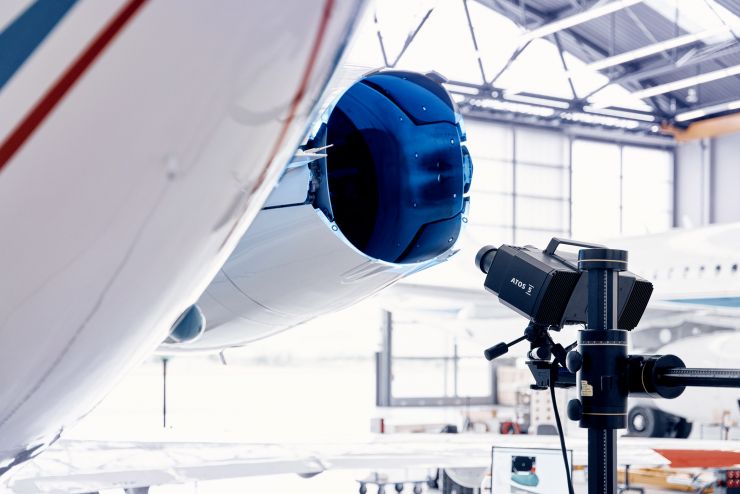Perfect for the MRO industry
Precision technology that stands out
Modern aircraft have a life expectancy of several decades. That is why the maintenance, repair, and overhaul (MRO) industry is working hard behind the scenes to ensure that fleets remain flying. Speed and efficiency play a significant role in this task. After all, the longer an aircraft is on the ground, the more expensive it becomes for the operator. Fast, precise 3D sensors for nondestructive inspection create a significant cost advantage here – while also meeting the aviation industry’s strict safety regulations.
Today’s MRO sector still relies on tools and processes developed over 50 years ago. For instance, inspection of dents or skin damage after a hailstorm, bird impact, or ground equipment impact is done visually and with pit gauges. This can take several hours per square meter of aircraft surface and immobilize the asset in maintenance, while being highly operator-dependent.
Unlike conventional measurement methods, GOM’s nondestructive testing (NDT) solutions are more precise, easy to operate, and create an accurate 3D model of the measured parts at high speed - a virtual copy, often also referred to as the digital twin. In the GOM software, this digital twin serves as the basis for inspection, trend analysis, simulation, reverse engineering, and efficient part repair. Dents, bumps, or local corrosion, for example, can be quantitatively analyzed and automatically documented based on objective criteria. Thus, the digital twin makes a major contribution to identifying and solving problems with defective OEM parts, such as turbine parts and interior components.
In addition, the powerful and user-friendly GOM software features comprehensive Geometric Dimensioning and Tolerancing (GD&T) analysis tools. It also has dedicated modules for airfoil and surface defect analysis that are constantly being developed to meet the high demands of OEMs and suppliers.



NDT solutions range from portable lightweight scanners to fully automated 3D measuring machines. Systems, such as the fast and precise ATOS 5 3D sensor, the automated ATOS ScanBox series, and the portable ZEISS T-SCAN hawk laser scanner are key to an optimized surface inspection process. All systems are easy to operate and make the measuring procedure more efficient.
Inspection methods in the MRO industry are changing from classic, lengthy, and therefore costly procedures to more efficient, digital measurement methods. GOM is one of the pioneers in this transformation process, making aircraft safer and drastically reducing the cost of maintenance operations.
Efficient analysis of surface defects and rapid 3D digitization enabling reverse engineering are just a small part of what 3D metrology can do for the aerospace industry. Research and development, quality control in production, and adaptive manufacturing, as well as final inspection all benefit from this.
The industry's gold standard
ATOS sensors and handheld portable scanners are the perfect tools for the MRO industry – they meet Nadcap standards and are used by most major aerospace manufacturers.
Learn more about GOM's Aerospace solutions
